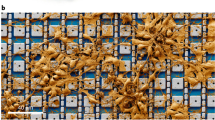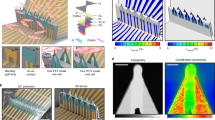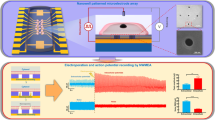Abstract
Developing a new tool capable of high-precision electrophysiological recording of a large network of electrogenic cells has long been an outstanding challenge in neurobiology and cardiology. Here, we combine nanoscale intracellular electrodes with complementary metal-oxide–semiconductor (CMOS) integrated circuits to realize a high-fidelity all-electrical electrophysiological imager for parallel intracellular recording at the network level. Our CMOS nanoelectrode array has 1,024 recording/stimulation ‘pixels’ equipped with vertical nanoelectrodes, and can simultaneously record intracellular membrane potentials from hundreds of connected in vitro neonatal rat ventricular cardiomyocytes. We demonstrate that this network-level intracellular recording capability can be used to examine the effect of pharmaceuticals on the delicate dynamics of a cardiomyocyte network, thus opening up new opportunities in tissue-based pharmacological screening for cardiac and neuronal diseases as well as fundamental studies of electrogenic cells and their networks.
This is a preview of subscription content, access via your institution
Access options
Access Nature and 54 other Nature Portfolio journals
Get Nature+, our best-value online-access subscription
$29.99 / 30 days
cancel any time
Subscribe to this journal
Receive 12 print issues and online access
$259.00 per year
only $21.58 per issue
Buy this article
- Purchase on Springer Link
- Instant access to full article PDF
Prices may be subject to local taxes which are calculated during checkout




Similar content being viewed by others
References
Herron, T. J., Lee, P. & Jalife, J. Optical imaging of voltage and calcium in cardiac cells & tissues. Circ. Res. 110, 609–623 (2012).
Cheng, H., Lederer, W. J. & Cannell, M. B. Calcium sparks: elementary events underlying excitation-contraction coupling in heart muscle. Science 262, 740–744 (1993).
Hou, J. H., Kralj, J. M., Douglass, A. D., Engert, F. & Cohen, A. E . Simultaneous mapping of membrane voltage and calcium in zebrafish heart in vivo reveals chamber-specific developmental transitions in ionic currents. Front. Physiol. 5, 344 (2014).
Matiukas, A. et al. New near-infrared optical probes of cardiac electrical activity. Am. J. Physiol. Heart Circ. Physiol. 290, H2633–H2643 (2006).
Matiukas, A. et al. Near-infrared voltage-sensitive fluorescent dyes optimized for optical mapping in blood-perfused myocardium. Heart Rhythm 4, 1441–1451 (2007).
Fromherz, P. Electrical interfacing of nerve cells and semiconductor chips. ChemPhysChem 3, 276–284 (2002).
Alivisatos, A. P. et al. The brain activity map. Science 339, 1284–1285 (2013).
Angle, M. R., Cui, B. & Melosh, N. A. Nanotechnology and neurophysiology. Curr. Opin. Neurobiol. 32, 132–140 (2015).
Robinson, J. T., Jorgolli, M. & Park, H . Nanowire electrodes for high-density stimulation and measurement of neural circuits. Front. Neural Circuits 7, 38 (2013).
Spira, M. E. & Hai, A. Multi-electrode array technologies for neuroscience and cardiology. Nature Nanotech. 8, 83–94 (2013).
Alivisatos, A. P. et al. Nanotools for neuroscience and brain activity mapping. ACS Nano 7, 1850–1866 (2013).
Viventi, J . et al. A conformal, bio-interfaced class of silicon electronics for mapping cardiac electrophysiology. Sci. Transl. Med. 2, 24ra22 (2010).
Viventi, J. et al. Flexible, foldable, actively multiplexed, high-density electrode array for mapping brain activity in vivo. Nat. Neurosci. 14, 1599–1605 (2011).
Kodandaramaiah, S. B., Franzesi, G. T., Chow, B. Y., Boyden, E. S. & Forest, C. R. Automated whole-cell patch-clamp electrophysiology of neurons in vivo. Nat. Methods 9, 585–587 (2012).
Eversmann, B. et al. A 128 × 128 CMOS biosensor array for extracellular recording of neural activity. IEEE J. Solid-State Circuits 38, 2306–2317 (2003).
Heer, F. et al. CMOS microelectrode array for bidirectional interaction with neuronal networks. IEEE J. Solid-State Circuits 41, 1620–1629 (2006).
Berdondini, L. et al. Active pixel sensor array for high spatio-temporal resolution electrophysiological recordings from single cell to large scale neuronal networks. Lab Chip 9, 2644 (2009).
Frey, U. et al. Switch-matrix-based high-density microelectrode array in CMOS technology. IEEE J. Solid-State Circuits 45, 467–482 (2010).
Huys, R. et al. Single-cell recording and stimulation with a 16k micro-nail electrode array integrated on a 0.18 μm CMOS chip. Lab Chip 12, 1274–1280 (2012).
Sileo, L. et al. Electrical coupling of mammalian neurons to microelectrodes with 3D nanoprotrusions. Microelectron. Eng. 111, 384–390 (2013).
Tsai, D., John, E., Chari, T., Yuste, R. & Shepard, K . High-channel-count, high-density microelectrode array for closed-loop investigation of neuronal networks. Proc. Annu. Int. Conf. IEEE Eng. Med. Biol. Soc. EMBS 7510–7513 (2015).
Fertig, N., Blick, R. H. & Behrends, J. C. Whole cell patch clamp recording performed on a planar glass chip. Biophys. J. 82, 3056–3062 (2002).
Lau, A. Y., Hung, P. J., Wu, A. R. & Lee, L. P. Open-access microfluidic patch-clamp array with raised lateral cell trapping sites. Lab Chip 6, 1510–1515 (2006).
Dunlop, J., Bowlby, M., Peri, R., Vasilyev, D. & Arias, R. High-throughput electrophysiology: an emerging paradigm for ion-channel screening and physiology. Nat. Rev. Drug Discov. 7, 358–368 (2008).
Robinson, J. T. et al. Vertical nanowire electrode arrays as a scalable platform for intracellular interfacing to neuronal circuits. Nat. Nanotech. 7, 180–184 (2012).
Xie, C., Lin, Z., Hanson, L., Cui, Y. & Cui, B. Intracellular recording of action potentials by nanopillar electroporation. Nat. Nanotech. 7, 185–190 (2012).
Lin, Z. C., Xie, C., Osakada, Y., Cui, Y. & Cui, B . Iridium oxide nanotube electrodes for sensitive and prolonged intracellular measurement of action potentials. Nat. Commun. 5, 3206 (2014).
Hochbaum, D. R. et al. All-optical electrophysiology in mammalian neurons using engineered microbial rhodopsins. Nat. Methods 11, 825–833 (2014).
Navarrete, E. G. et al. Screening drug-induced arrhythmia using human induced pluripotent stem cell-derived cardiomyocytes and low-impedance microelectrode arrays. Circulation 128, S3–S13 (2013).
Kannankeril, P. J. & Roden, D. M. Drug-induced long QT and torsade de pointes: recent advances. Curr. Opin. Cardiol. 22, 39–43 (2007).
Stett, A. et al. Biological application of microelectrode arrays in drug discovery and basic research. Anal. Bioanal. Chem. 377, 486–495 (2003).
Itzhaki, I. et al. Modelling the long QT syndrome with induced pluripotent stem cells. Nature 471, 225–229 (2011).
Buzsáki, G. Large-scale recording of neuronal ensembles. Nat. Neurosci. 7, 446–451 (2004).
Gollisch, T. & Meister, M. Eye smarter than scientists believed: neural computations in circuits of the retina. Neuron 65, 150–164 (2010).
Yuste, R. From the neuron doctrine to neural networks. Nat. Rev. Neurosci. 16, 487–497 (2015).
Shalek, A. K. et al. Vertical silicon nanowires as a universal platform for delivering biomolecules into living cells. Proc. Natl Acad. Sci. USA 107, 1870–1875 (2010).
Duan, X. et al. Intracellular recordings of action potentials by an extracellular nanoscale field-effect transistor. Nat. Nanotech. 7, 174–179 (2011).
Tian, B. et al. Three-dimensional, flexible nanoscale field-effect transistors as localized bioprobes. Science 329, 830–834 (2010).
Hai, A., Shappir, J. & Spira, M. E. In-cell recordings by extracellular microelectrodes. Nat. Methods 7, 200–202 (2010).
Vandersarl, J. J., Xu, A. M. & Melosh, N. A. Nanostraws for direct fluidic intracellular access. Nano Lett. 12, 3881–3886 (2012).
Xie, X. et al. Nanostraw-electroporation system for highly efficient intracellular delivery and transfection. ACS Nano 7, 4351–4358 (2013).
Franks, W., Schenker, I., Schmutz, P. & Hierlemann, A. Impedance characterization and modelling of electrodes for biomedical applications. IEEE Trans. Biomed. Eng. 52, 1295–1302 (2005).
Varró, A., Lathrop, D. A., Hester, S. B., Nánási, P. & Papp, J. G. Ionic currents and action potentials in rabbit, rat, and guinea pig ventricular myocytes. Basic Res. Cardiol. 2, 93–102 (1993).
Chang, M. G. et al. Proarrhythmic potential of mesenchymal stem cell transplantation revealed in an in vitro coculture model. Circulation 113, 1832–1841 (2006).
Yue, L., Xie, J. & Nattel, S. Molecular determinants of cardiac fibroblast electrical function and therapeutic implications for atrial fibrillation. Cardiovasc. Res. 89, 744–753 (2011).
Natarajan, A. et al. Patterned cardiomyocytes on microelectrode arrays as a functional, high information content drug screening platform. Biomaterials 32, 4267–4274 (2011).
Shryock, J. C., Song, Y., Rajamani, S., Antzelevitch, C. & Belardinelli, L. The arrhythmogenic consequences of increasing late INa in the cardiomyocyte. Cardiovasc. Res. 99, 600–611 (2013).
Maruyama, M. et al. Genesis of phase 3 early afterdepolarizations and triggered activity in acquired long-QT syndrome. Circ. Arrhythmia Electrophysiol. 4, 103–111 (2011).
Chang, M. G. et al. Bi-stable wave propagation and early afterdepolarization-mediated cardiac arrhythmias. Heart Rhythm 9, 115–122 (2012).
Acknowledgements
The authors thank J. MacArthur, G. Zhong, D. Ha, B. Tinner and B. VanderElzen for scientific discussions and technical assistance. The CNEA post-fabrication and characterization were performed, in part, at the Center for Nanoscale Systems at Harvard University. The authors are grateful for the support of this research by Catalyst foundation, Valhalla, New York (J.A., D.H. and H.P.), the Army Research Office (W911NF-15-1-0565 to D.H.), the National Institutes of Health (1-U01-MH105960-01 to H.P.), the Gordon and Betty Moore Foundation (to H.P.), and the US Army Research Laboratory and the US Army Research Office (W911NF1510548 to H.P.).
Author information
Authors and Affiliations
Contributions
H.P., D.H., J.A., T.Y., L.Q. and M.J. conceived and designed the experiments. J.A. and L.Q. designed the CMOS IC, and T.Y. and M.J performed post-fabrication of nanoelectrodes. J.A., T.Y., M.J. and R.S.G. performed the experiments, and J.A., T.Y., D.H. and H.P. analysed the data. H.P. and D.H. supervised the project. J.A., T.Y., D.H. and H.P. wrote the manuscript, and all authors read and discussed it.
Corresponding authors
Ethics declarations
Competing interests
The authors declare no competing financial interests.
Supplementary information
Supplementary information
Supplementary information (PDF 1429 kb)
Supplementary information
Supplementary Movie 1 (MP4 5433 kb)
Supplementary information
Supplementary Movie 2 (MP4 8072 kb)
Supplementary information
Supplementary Movie 3 (MP4 10215 kb)
Supplementary information
Supplementary Movie 4 (MP4 811 kb)
Rights and permissions
About this article
Cite this article
Abbott, J., Ye, T., Qin, L. et al. CMOS nanoelectrode array for all-electrical intracellular electrophysiological imaging. Nature Nanotech 12, 460–466 (2017). https://doi.org/10.1038/nnano.2017.3
Received:
Accepted:
Published:
Issue Date:
DOI: https://doi.org/10.1038/nnano.2017.3
This article is cited by
-
Active Micro-Nano-Collaborative Bioelectronic Device for Advanced Electrophysiological Recording
Nano-Micro Letters (2024)
-
Micro/nanoelectrode-based electrochemical methodology for single cell and organelle analysis
Nano Research (2024)
-
Sensors-integrated organ-on-a-chip for biomedical applications
Nano Research (2023)
-
Nanomaterials based flexible devices for monitoring and treatment of cardiovascular diseases (CVDs)
Nano Research (2023)
-
Buckled scalable intracellular bioprobes
Nature Nanotechnology (2022)



